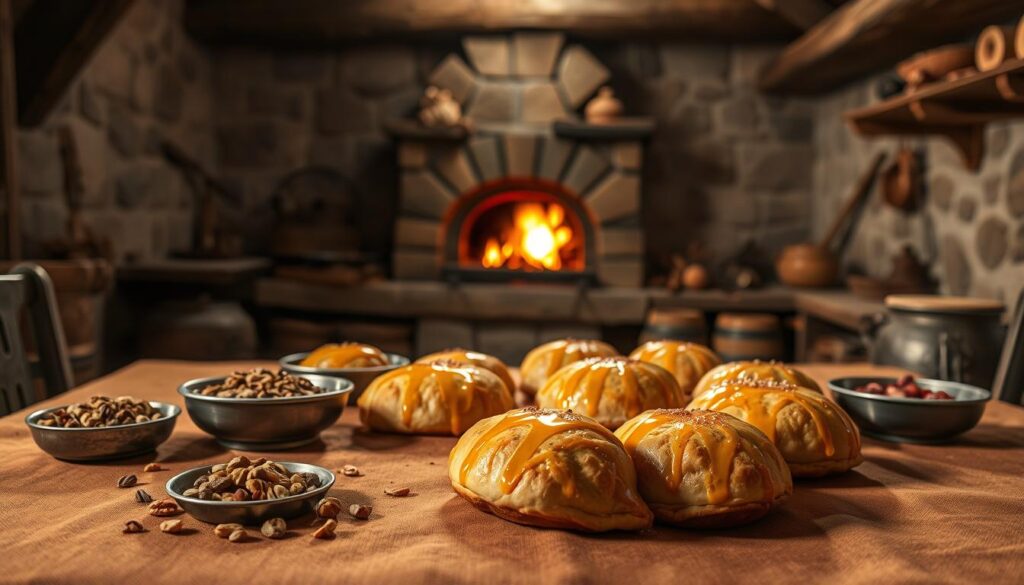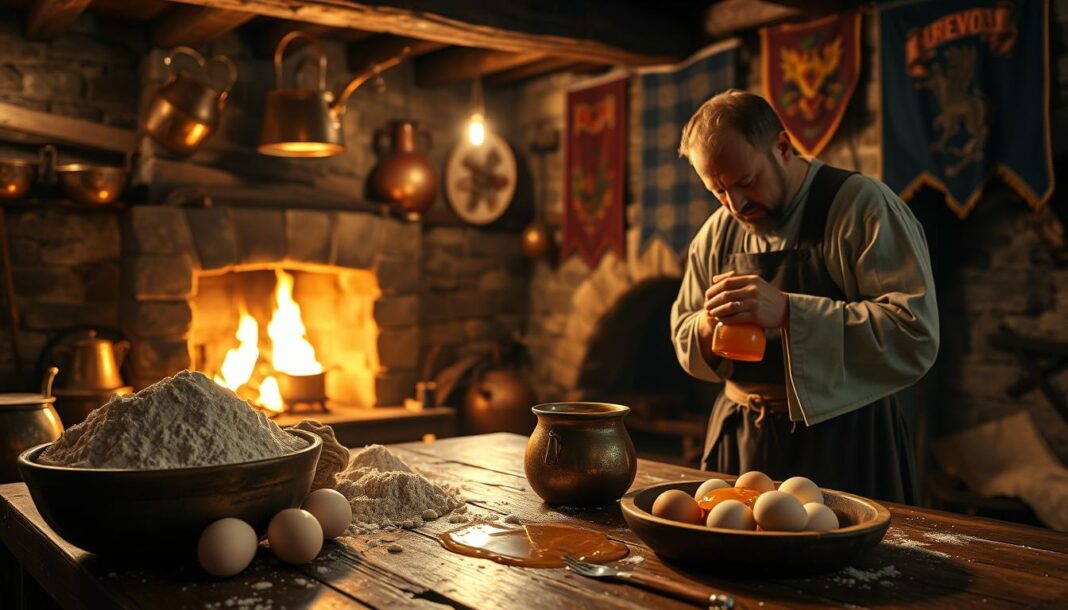We delve into the fascinating world of historical baking, where honey was the primary sweetener. The use of honey in baking dates back millennia, with ancient civilizations such as the Egyptians and Romans utilizing it to create sweet treats.
The earliest cakes were likely made from mashed legumes and honey, baked in the ancient Near East. As baking techniques evolved, so did the ingredients and methods, reflecting the cultural and culinary practices of the time.
Our exploration reveals that historical baking was not just about sustenance, but about creating cultural artifacts that reflected the available ingredients and cooking technologies. By understanding these historical baking practices, we gain insight into the evolution of culinary arts.
Key Takeaways
- Historical baking relied heavily on honey as a primary sweetener.
- Ancient baking techniques and ingredients influenced the development of later culinary practices.
- Understanding historical recipes provides insight into the evolution of baking.
- Medieval baking was characterized by dense and less sweet treats.
- The use of limited ingredients showcased the ingenuity of historical bakers.
The Rich History of Medieval Honey Cakes
In medieval Europe, honey cakes were more than just a sweet treat; they held cultural and symbolic significance. These cakes were intricately linked to various traditions and ceremonies, reflecting their importance in the social fabric of the time.
Ancient Origins and European Spread
The tradition of baking honey cakes dates back to ancient times, influencing medieval European baking practices. As trade and cultural exchange flourished, recipes for these sweet treats spread across the continent, adapting to local ingredients and customs. The use of honey and flour in these recipes was particularly significant, as they were staples in medieval baking.

Cultural Significance in Medieval Jewish Traditions
In medieval Jewish communities, honey cakes played a pivotal role in various ceremonies, including the Aleph-Bet ceremony marking a child’s first day of school. The tradition involved smearing honey on a slate with Hebrew letters for the child to lick, symbolically connecting learning with sweetness. For more on the history of honey cakes, visit The Honey Cake: Then and Now.
Authentic Medieval Cake Recipe
Let’s dive into the authentic medieval cake recipe from the 13th century. This historical recipe provides a unique glimpse into the baking practices of the past.
13th-Century Recipe Translation
The original recipe calls for 3 cups of cake flour and 1 cup of honey, among other ingredients. Translating this recipe for modern bakers requires understanding the ingredients and techniques used during that period.
Ingredients and Substitutions
To make this medieval cake, you’ll need 3 cups of cake flour, 1 cup of honey, ½ cup of oil, and ½ cup of milk (dairy or plant-based). For authenticity, consider using walnut or hazelnut oil.
Step-by-Step Baking Instructions
Begin by preheating your oven to 350°F (180°C). Prepare a 9-inch round cake pan by lining the bottom with parchment paper and oiling the interior. Mix the flour and honey together until combined, then incorporate the oil and milk. The resulting dough should have a Play-Doh-like consistency. Spread it into the prepared pan and bake for 35-40 minutes. The cake is best served warm, with a dense texture similar to bread or scones.
How Medieval Cakes Differ From Modern Versions
Medieval cakes were a far cry from the fluffy, sugar-laden treats we’re accustomed to today. We recognize that the absence of certain ingredients and techniques significantly impacted the final product.
Texture and Density Differences
Medieval cakes were dense, thanks to the lack of leavening agents like baking powder and baking soda. The flour used was also coarser than today’s refined flour, contributing to the dense texture.
Flavor Profile Without Modern Ingredients
The flavor profile of medieval cakes was distinct, with honey serving as the primary sweetener due to the scarcity of sugar. The absence of modern ingredients like vanilla and chocolate also shaped the flavor.
What Medieval Bakers Didn’t Have Access To
Medieval bakers lacked many ingredients we consider essential today, including refined sugar and chemical leavening agents. They also didn’t have access to butter in the same quantities as modern bakers, often substituting it with oils. Additionally, the use of eggs as leavening agents was not fully understood, affecting the texture of cakes. For more information on medieval baking, you can explore our article on honey-based medieval treats.
Tips for Successfully Recreating This Historical Treat
As we conclude our exploration of medieval baking, here are some key takeaways for recreating this historical treat. To achieve an authentic medieval cake, using high-quality honey is crucial, as its flavor dominates the cake and creates the authentic medieval experience. When mixing the ingredients, aim for a Play-Doh-like consistency rather than the pourable batter typical of contemporary cake recipes.
To get started, consider warming your honey slightly before mixing to make it easier to incorporate with the flour and other ingredients. You may also want to experiment with different types of flour, from cake flour to whole wheat, to find a texture that balances authenticity with palatability for modern tastes. Remember, medieval baking was imprecise by modern standards—don’t be afraid to adjust ingredients slightly based on how your dough feels and looks.
When serving, consider enjoying your medieval cake slightly warm, perhaps alongside spiced wine or mead for a truly historical experience. By following these tips and being patient during the mixing process, you’ll be able to create a delicious and historically accurate medieval cake using this ancient recipe and traditional baking methods, measuring ingredients in a traditional cup.


